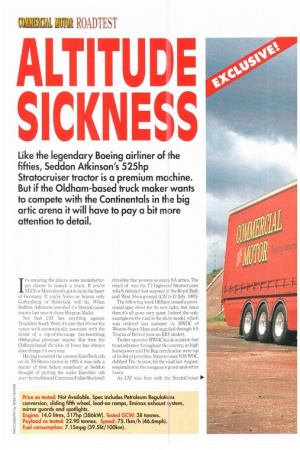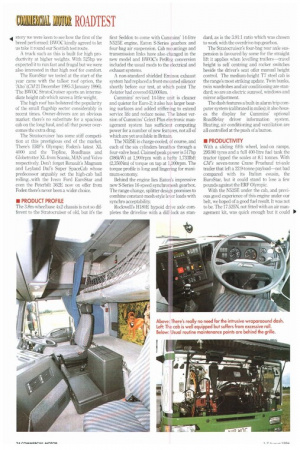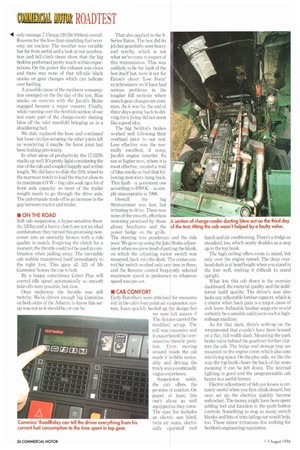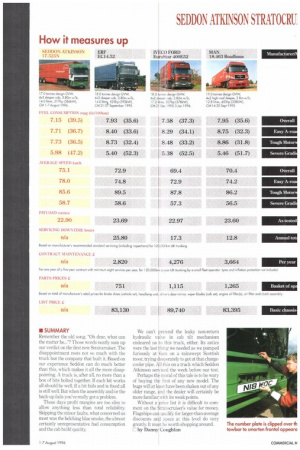ALTI TUDE
Page 24

Page 26

Page 28

Page 29

If you've noticed an error in this article please click here to report it so we can fix it.
SICKNESS
/t's amazing the places some manufacturers choose to launch a truck. If you're MAN or Mercedes it's got to be in the heart of Germany. If you're Volvo or Scania only Gothenburg or SOdertalje will do. When Seddon Atkinson unveiled it's StratoCruiser tractor last year it chose Shepton Mallet.
Not that CM has anything against Truckfest South West; it's just that it's not the venue we'd automatically associate with the debut of a top-of-the-range fire-breathing 500hp-plus premium tractor. But then the Oldham-based division of Iveco has always done things its own way.
Having mounted the current EuroTech cab on its T6 Strato tractor in 1993 it was only a matter of time before somebody at Seddon thought of putting the wider EuroStar cab over the traditional Cummins/Fuller/Rockwell driveline that powers so many SA artics. The result of was the T7 high-roof Stratocruiser which debuted last summer at the Royal Bath and West Showground (CM 6-12 July 1995).
The following week Oldham issued a provisional spec sheet for its new baby, but since then it's all gone very quiet. Indeed the only example on the road is the show model, which was ordered last summer by BWOC of Weston-Super-Mare and supplied through SA Trucks of Bristol (now an ERF dealer).
Tanker operator BWOC hauls aviation fuel to aerodromes throughout the country, so high horsepower and Pet Reg certification were top of its list of priorities. Stratocruiser N18 WOC, dubbed The Aviator, hit the road last August, resplendent in the company's green-and-white livery As CM was first with the StratoCruiser story we were keen to see how the first of the breed performed: 13WOC kindly agreed to let us take it round our Scottish test route.
A truck such as this is built for high productivity at higher weights. With 525hp we expected it to run fast and frugal but we were also interested in that high roof for comfort.
The EuroStar we tested at the start of the year came with the tallest roof option, the Alto' (CM21 December 1995-3 January 1996). The BWOC StratoCruiser sports an intermediate height cab which saves a little weight.
The high roof has bolstered the popularity of the small flagship sector considerably in recent times. Owner-drivers are an obvious market: there's no substitute for a spacious cab on the long haul, and all that power overcomes the extra drag.
The Stratocruiser has some stiff competition at this prestigious end of the market. There's ERF's Olympic; Foden's latest XL 4000 and the Topline, Roadhaus and Globetrotter XL from Scania.M.AN and Volvo respectively. Don't forget Renault's Magnum and Leyland Daf's Super SpaceCab whose predecessor arguably set the high-cab ball ro!ling...with the Iveco Ford EuroStar and even the Peterbilt 362E now on offer from Foden there's never been a wider choice, The 3.8m-wheelbase 4x2 chassis is not so different to the Stratocruiser of old, but it's the first Seddon to come with Cummins' 14-litre N525E engine. Eaton S-Series gearbox and four-bag air suspension. Cab mountings and transmission links have also changed in the new model and BWOC's PetReg conversion included the usual mods to the electrical and exhaust systems.
A non-standard shielded Eminox exhaust system had replaced a front-mounted silencer shortly before our test, at which point The Aviator had covered 63,000km.
Cummins' revised 14-litre unit is cleaner and quieter for Euro-2; it also has larger bearing surfaces and added stiffening to extend service life and reduce noise. The latest version of Cummins' Celect Plus electronic management system has sufficient computing power for a number of new features, not all of which are yet available in Britain.
The N525E is charge-cooled, of course, and each of the six cylinders breathes through a four-valve head. Claimed peak power is 517hp (386kW) at 1,900rpm with a hefty 1,7331bft (2,350Nm) of torque on tap at 1,200rpm. The torque profile is long and lingering for maximum economy.
Behind the engine lies Eaton's impressive new S-Series 16-speed synchromesh gearbox. The range-change, splitter design promises to combine constant-mesh-style lever loads with synchro acceptability.
Rockwell's H180E hypoid drive axle completes the driveline with a diff-lock as stan
dard, as is the 3.91:1 ratio which was chosen to work with the overdrive-top gearbox.
The Stratocruiser's four-bag rear axle suspension is favoured by some for the straight lift it applies when levelling trailers—travel height is self centring and rocker switches beside the driver's seat offer manual height control. The medium-height T7 steel cab is the range's most striking update. Twin bunks, twin wardrobes and air conditioning are standard; so are an electric sunroof, windows and mirror adjustment.
The dash features a built-in alarm/trip computer system (calibrated in miles); it also houses the display for Cummins' optional RoadRelay driver information system. Heating, air conditioning and ventilation are all controlled at the push of a button.
With a sliding fifth wheel, lead-on ramps, 295i80 tyres and a full 400-litre fuel tank the tractor tipped the scales at 8.1 tonnes. With CM's seven-tonne Crane Fruehauf tri-axle trailer that left a 22.9-tonne payload—not bad compared with its Italian cousin, the EuroStar, but it could stand to lose a few pounds against the ERF Olympic.
With the N525E under the cab, and previous good experience of this engine under our belt, we hoped of a good fuel result. It was not to be. The 17.525N. not fitted with an air management kit, was quick enough but it could 110
41 only manage 7.15mpg (39.51i ti I tntr) overall. Reasons for the less-than-sparkling fuel economy are unclear. The weather was variable but far from awful and a look at our acceleration and hill-climb times show that the big Seddon performed pretty much within expectations. On the power the exhaust was clean and there was none of that tell-tale black smoke on gear changes which can indicate over fuelling.
A possible cause of the mediocre consumption emerged on the the day of the test. Blue smoke on overrun with the Jacob's Brake engaged became a major concern. Finally, while running over the Scottish section of our test route part of the charge-cooler ducting blew off the inlet manifold bringing us to a shuddering halt.
We duly replaced the hose and continued but loose circlips securing the other joints left us wondering if maybe the burst joint had been leaking previously.
In other areas of productivity the 17.525N stacks up well. It's pretty light considering the size of the cab and coupled happily and within length. We did have to slide the fifth wheel to the rearmost notch to load the tractor close to its maximum G VW—big cabs soak up a lot of front axle capacity so most of the trailer weight needs to go through the drive axle. The unfortunate trade-off is an increase in the gap between tractor and trailer.
Soft cab suspension, a hyper-sensitive throttle, 525hp and a heavy clutch are not an ideal combination: they turned this promising newcomer into an unwieldy bronco with a ride quality to match. Forgiving the clutch for a moment, the throttle could not be used in combination when pulling away. The inevitable cab wobble transferred itself immediately to the right foot. This gave all 525 of Mr Cummins' horses the cue to bolt.
By a happy coincidence Celect Plus will control idle speed automatically so smooth take-offs were possible, but slow.
Once underway the throttle was still twitchy. We've driven enough big Cummins on both sides of the Atlantic to know this setup was not as it should be, or can be.
That also applied to the 5Series Eaton. The box did its job but gearshifts were heavy and notchy, which is not what we've come to expect of this transmission. This was unlikely to be the fault of the box itself but, were it not for Eaton's clever low Force' synchronisers we'd have had serious problems in the tougher hill sections where snatch gear changes are common. As it was by the end of three days going back to driving for a living did not seem like a good idea.
The big Seddon's brakes worked well following their overhaul prior to our test. Less effective was the normally excellent, if noisy, Jacob's engine retarder. Its use at higher revs, where it is most effective, created a trail of blue smoke so had that following motorists hung back. This fault a persistent one according to BWOC is simply unacceptable in 1996.
Overall the big Stratocruiser was fast, but irritating to drive. There was none of the smooth, effortless motoring promised by those glossy brochures and the power badge on the grille. The steering was ponderous and the ride poor. We gave up using the Jake Brake adjustment when we grew tired of putting the blank, on which the adjusting rocker switch was mounted, back into the dash. The cruise control Set switch worked only one time in three, and the Resume control frequently selected maximum speed in preference to whatever speed was pre-set.
Early EuroStars were criticised for excessive roll in the cab's four-point air suspension systera lveco quickly beefed up the design but we were left unsure if The Aviator carried the modified set-up. The roll was excessive and it exacerbated the oversensitive throttle problem. Even moving around inside the cab made it wobble noticeably and driving the truck was a continually vague experience.
Suspension aside, the cab offers the promise of comfort. On paper, at least, this one's about as well equipped as they come. The spec list includes an electric sun blind, twin air seats, electrically operated roof hatch and air conditioning. There's a fridge as standard, too, which neatly doubles as a step up to the top bunk.
The high ceiling offers room to stand, but only over the engine tunnel. The deep overhead dash is at head height when you stand in the foot well, making it difficult to stand upright, What lets this cab down is the oversize dashboard, the material quality and the indifferent build quality. The driver's seat also lacks any adjustable lumbar support, which is a shame when back pain is a major cause of sick leave. Inflatable lumbar supports would certainly be a sensible addition to such a highmileage machine.
As for that dash, there's nothing on the wraparound that couldn't have been housed on a flat, full-width dash. Mounting the park brake valve behind the gearlever further clutters the cab. The fridge and storage tray are mounted on the engine cover, which also eats into living space. On the plus side, we like the way the top hunk clears the back of the seats meaning it can be left down. The internal lighting is good and the programmable cab heater is a useful feature.
Electric adjustment of fish eye lenses is certainly useful when you first climb aboard, but once set up the electrics quickly become redundant. The money might have been spent adding feel and function to the push button controls. Something to stop so many switch blanks and bits of trim falling out would help, too. These minor irritations duo nothing for Seddon's engineering reputation.
Remember the old song, "Oh dear, what can the matter be..."? Those words neatly sum up our verdict on the first new Stratocruiser. The disappointment rests not so much with the truck but the company that built it. Based on our experience Seddon can do much better than this, which makes it all the more disappointing. A truck is, after all, no more than a box of bits bolted together. If each bit works all should be well. If a bit fails and is fixed all is still well. But when the assembly and/or the back-up fails you've really got a problem.
These days profit margins are too slim to allow anything less than total reliability. Skipping the minor faults, what concerned us most was the belching blue smoke, the almost certainly unrepresentative fuel consumption and the cab build quality. We can't pretend the leaky non-return hydraulic v3lve in cab tilt mechanism endeared us to this truck. either. Its antics were the last thing we needed as we pumped
furiously at on a rainswept Scottish moor, trying desperately to get at that chargecooler pipe. All this on a truck which Seddon Atkinson serViced the week before our test.
Perhaps the moral of this tale is to be wary of buying the first of any new model. The bugs will at least have been shaken out of any older range. and the dealer will certainly be more familial, with its weak points Without a price list it is difficult to comment on the Stratocruiser's value for money. Flagships can qualify for larger-than-average discounts and specs at this level do vary greatly. It must be worth shopping around.




































































































